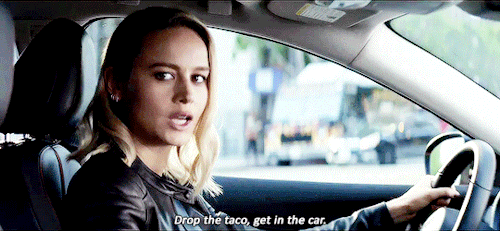We need to arm our kids to survive in the marketing arena.
Our work as parents begins early because advertisers target preschoolers, and “kids can’t distinguish between marketing fact and fiction until they’re eight” (Calvert, Children as Consumers, pp 214-216).
And once our kids move beyond the perceptual stage (ages 3-7) into the analytical (ages 7-11) and then reflective (ages 11-16) stages, they (well, in truth, we all) remain vulnerable to marketing ploys.
The marketing arena reminds me of the scene in Jurassic Park in which the game warden doesn’t realize velociraptors are hunting him until it’s too late.

Like velociraptors, marketers study our behavior to know what we’re going to do next sooner than we know ourselves.
If our kids are to survive in this arena, then we must equip them with defensive armor.
The first step is recognizing that we’re under attack. If the warden recognized he was being hunted by more than one raptor, then he either wouldn’t have ventured out or would have done so with more protection.
In the marketing arena, a greater asymmetry exists, one that is more significant than three raptors going after one warden. In this case, just one advertisement, for example, contains the creative ideas of the person or team who drew it up based upon concepts that have been honed and refined over generations — the influence of thousands, if not millions, of minds.
What follows is an introduction to preparing our kids for the arena.
This article identifies a bevy of marketing tricks about which we must be wary. I’ve distilled the list of twenty into three main categories that we can discuss with our kids.
-One-
Assume all endorsements are paid endorsements.
I’d love to believe that Brie Larson is driving the Nissan Rogue that she’s hawking (hilariously) in ads. But don’t we all know that she’s more likely to be tooling around town in a Tesla Model S that’s three times the price?
Our kids may not, though. Suppose the advertiser has done his or her job. In that case, kids will associate the car with the star when it comes time to decide which vehicles to consider, even though the star has absolutely nothing to do with the advertised item (other than receiving payment for services rendered).

-Two-
Beware false urgency.
This category covers a few of the hammers marketers use to bludgeon us into buying. These tools include bins of sale items, limited-time offers and open-the-wallet discounts.
Sale bins are like treasure hunts. Indiana Jones taught us that it’s essential to act quickly if we want to secure a treasure. So we jump at the chance.
We also confuse limited-time offers with once-in-a-lifetime offers.
While we’re at it, let’s teach our kids to avoid “crappance,” the cheap clearance garbage positioned in unavoidable store locations (like checkout lines) to trick us into thinking a deal is can’t-miss or an item is something we may need.
The odds are pretty good that we don’t need another $1 mini spritzer of Poo-Pourri.
This neatly segues into…
-Three-
Don’t buy extra stuff you don’t need.
Every tactic mentioned in this essay encourages us to buy. Most of what we purchase is stuff, which by definition is neither a need nor even a needlet, a term I coined in this essay to describe something you don’t need to survive but do need in a specific situation. For example, you need a ball to play basketball. The ball is a needlet.
Retailers offer free samples because these items effectively coax money from our wallets by encouraging us either to buy said samples or to keep shopping. It’s important to remember that there’s a cost to free stuff.
Then there are recommended products, which are like YouTube suggestions — they often lead us down a rabbit hole of spending.
Meanwhile, free shipping thresholds encourage us to save on shipping by spending even more money on stuff.
If you want to explore this concept further, I wrote extensively about the scourge of stuff in my book, The Art of Allowance: A Short, Practical Guide to Raising Money-Smart, Money-Empowered Kids.
-Closing-
We can help our kids by arming them with simple strategies to combat marketing ploys.
Everybody loves free samples. I certainly do too! They are fantastic (Hello, Costco Saturdays!) as long as we’re enjoying something we’d like to try and we don’t end up with a shopping cart full of family-size Honey Nut Circles and mini sausages. A simple strategy for not succumbing to free samples — make a list before you go, and stick to it.
Use The Waiting Period tactic to deal with urgency. If something is over $50, then wait a week to buy it. Maybe wait two weeks for something that’s over $100. You can even apply this approach to items less than $50 if you’d like. Of course, sometimes a thing we’ve wanted for months is available in a time-limited deal. In that case, our kids (or we) should go for it!
In a world where fact and fiction can often be difficult to distinguish, we must help our kids (and ourselves) by separating the product from the endorser, fortifying them against false urgency and consciously minimizing our acquisition of stuff.
We’ll help our kids not only survive but also thrive. We might even help ourselves in the process.
After all, we’re all in the marketing arena.
John
I want to thank Erin Prim and The Foster Writing Community (Tom White, Charlene Wang, Miranda Newman and Alberto Sadde) for helping me edit this essay.
If you’re interested, here is some additional helpful reading and source material:
https://www.commonsensemedia.org/blog/sneaky-ways-advertisers-target-kids
https://mediasmarts.ca/marketing-consumerism/marketing-consumerism-special-issues-young-children
Featured Photo 139378054 / Kid Armor © Olga Trifonova | Dreamstime.com
